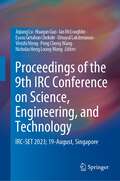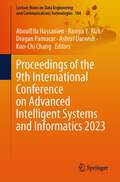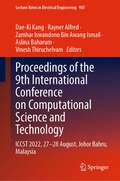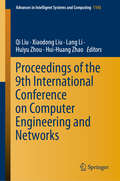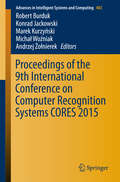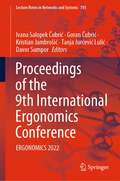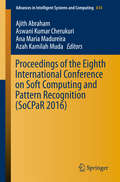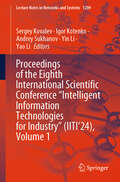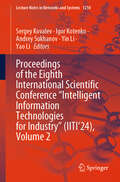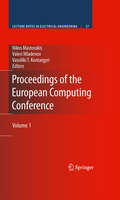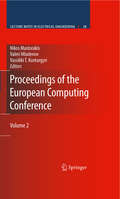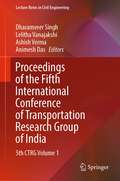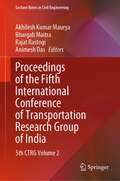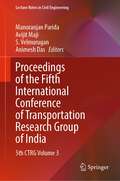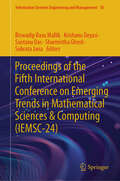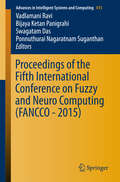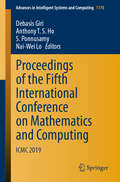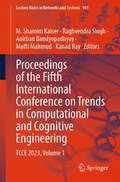- Table View
- List View
Proceedings of the 9th IRC Conference on Science, Engineering, and Technology: IRC-SET 2023; 19-August, Singapore
by Weizhi Meng Huaqun Guo Eyasu Getahun Chekole Umayal Lakshmanan Ian McLoughlin Peng Cheng Wang Jiqiang Lu Nicholas Heng Loong WongThis book highlights the contemporary state of research in multidisciplinary areas of Computer Science, Computer Engineering, Data Science, Electrical and Electronics Engineering, Chemical Engineering, Mechanical Engineering, Physics, Biomedical Sciences, Life Sciences, Medicine, Healthcare, and Business Technology. The accepted submissions to the 9th IRC Conference on Science, Engineering and Technology (IRC-SET 2023) presented on 19 August 2023 are published in this conference proceedings. The papers presented here were shortlisted after extensive rounds of rigorous reviews by a panel of esteemed individuals who are pioneers and experts in their respective domains.
Proceedings of the 9th International Conference on Advanced Intelligent Systems and Informatics 2023 (Lecture Notes on Data Engineering and Communications Technologies #184)
by Ashraf Darwish Kuo-Chi Chang Dragan Pamucar Rawya Y. Rizk AboulElla HassanienThis proceedings book constitutes the refereed proceedings of the 9th International Conference on Advanced Intelligent Systems and Informatics (AISI 2023), which took place in Port Said University, Port Said, Egypt, during September 20–22, 2023, Egypt, and is an international interdisciplinary conference that presents a spectrum of scientific research on all aspects of informatics and intelligent systems, technologies, and applications.
Proceedings of the 9th International Conference on Computational Science and Technology: ICCST 2022, 27–28 August, Johor Bahru, Malaysia (Lecture Notes in Electrical Engineering #983)
by Rayner Alfred Dae-Ki Kang Zamhar Iswandono Bin Awang Ismail Aslina Baharum Vinesh ThiruchelvamThis book gathers the proceedings of the 9th International Conference on Computational Science and Technology (ICCST 2022), held in Johor Bahru, Malaysia, on August 27–28, 2022. The respective contributions offer practitioners and researchers a range of new computational techniques and solutions, identify emerging issues, and outline future research directions, while also showing them how to apply the latest large-scale, high-performance computational methods.
Proceedings of the 9th International Conference on Computer Engineering and Networks (Advances in Intelligent Systems and Computing #1143)
by Huiyu Zhou Qi Liu Xiaodong Liu Lang Li Hui-Huang ZhaoThis book gathers papers presented at the 9th International Conference on Computer Engineering and Networks (CENet2019), held in Changsha, China, on October 18–20, 2019. It examines innovations in the fields of computer engineering and networking and explores important, state-of-the-art developments in areas such as Information Security, Information Hiding and Cryptography, Cyber Security, and Intelligent Computing and Applications. The book also covers emerging topics in computer engineering and networking, along with their applications, discusses how to improve productivity by using the latest advanced technologies, and examines innovation in the fields of computer engineering and networking, particularly in intelligent computing and security.
Proceedings of the 9th International Conference on Computer Recognition Systems CORES 2015
by Konrad Jackowski Robert Burduk Michał Woźniak Marek Kurzyński Andrzej ŻołnierekThe computer recognition systems are nowadays one of the most promising directions in artificial intelligence. This book is the most comprehensive study of this field. It contains a collection of 79 carefully selected articles contributed by experts of pattern recognition. It reports on current research with respect to both methodology and applications. In particular, it includes the following sections: Features, learning, and classifiers Biometrics Data Stream Classification and Big Data Analytics Image processing and computer vision Medical applications Applications RGB-D perception: recent developments and applications This book is a great reference tool for scientists who deal with the problems of designing computer pattern recognition systems. Its target readers can be the as well researchers as students of computer science, artificial intelligence or robotics.
Proceedings of the 9th International Conference on Fracture, Fatigue and Wear: FFW 2021, August 2–3, Ghent University, Belgium (Lecture Notes in Mechanical Engineering)
by Magd Abdel WahabThis proceedings gather a selection of peer-reviewed papers presented at the 9th International Conference on Fracture Fatigue and Wear (FFW 2021), held in the city of Ghent, Belgium on 2–3 August 2021. The contributions, prepared by international scientists and engineers, cover the latest advances in and innovative applications of fracture mechanics, fatigue of materials, tribology, and wear of materials. In addition, they discuss industrial applications and cover theoretical and analytical methods, numerical simulations and experimental techniques. The book is intended for academics, including graduate students and researchers, as well as industrial practitioners working in the areas of fracture fatigue and wear.
Proceedings of the 9th International Ergonomics Conference: ERGONOMICS 2022 (Lecture Notes in Networks and Systems #701)
by Davor Sumpor Kristian Jambrošić Tanja Jurčević Lulić Ivana Salopek Čubrić Goran ČubrićThis book presents the proceedings of the 9th International Ergonomics Conference (ERGONOMICS), held in Zagreb, Croatia, on December 7–10, 2022. By highlighting the latest theories and models, as well as cutting-edge technologies and applications, and by combining findings from a range of disciplines including engineering, design, robotics, health care, management, computer science, human biology, and behavioral science, it provides researchers and practitioners alike with a comprehensive, timely guide on human factors and ergonomics. It also offers an excellent source of innovative ideas to stimulate future discussions and developments aimed at applying knowledge and techniques to optimize system performance, while at the same time promoting the health, safety, and well-being of individuals. The proceedings includes papers from researchers and practitioners, scientists and physicians, institutional leaders, managers, and policy makers that contribute to constructing the human factors and ergonomics approach across a variety of methodologies, domains, and productive sectors.
Proceedings of the 9th International Symposium on Linear Drives for Industry Applications, Volume 1
by Xiaozhu Liu Yunyue YeThe 9th International Symposium on Linear Drives for Industry Applications (LDIA 2013) was held on July 7-10, 2013 in Hangzhou, China. The LDIA 2013 was organized by Zhejiang University, a leading comprehensive university in China, and offered a venue for leading academic and industrial researchers to exchange their views, ideas and findings on innovative technologies and sustainable solutions leading to linear drivers and intelligence applications. The conference featured keynote speakers, a panel discussion and paper presentations. The objective of the LDIA 2013 is to facilitate the exchange of information on best practices and to profile the latest research advances in the areas of linear drive technologies, control theory, information engineering, control engineering and intelligence applications, which mainly concern the fields of Engineering and Computer Science, Informatics, Communications and Control etc. The proceedings are intended for scientists, engineers and graduate students in Engineering and Computer Science, especially those focusing on linear drives.
Proceedings of the 9th International Symposium on Linear Drives for Industry Applications, Volume 2
by Xiaozhu Liu Yunyue YeThe 9th International Symposium on Linear Drives for Industry Applications (LDIA 2013) was held on July 7-10, 2013 in Hangzhou, China. The LDIA 2013 was organized by Zhejiang University, a leading comprehensive university in China, and offered a venue for leading academic and industrial researchers to exchange their views, ideas and findings on innovative technologies and sustainable solutions leading to linear drivers and intelligence applications. The conference featured keynote speakers, a panel discussion and paper presentations. The objective of the LDIA 2013 is to facilitate the exchange of information on best practices and to profile the latest research advances in the areas of linear drive technologies, control theory, information engineering, control engineering and intelligence applications, which mainly concern the fields of Engineering and Computer Science, Informatics, Communications and Control etc. The proceedings are intended for scientists, engineers and graduate students in Engineering and Computer Science, especially those focusing on linear drives.
Proceedings of the 9th International Symposium on Linear Drives for Industry Applications, Volume 3
by Xiaozhu Liu Yunyue YeThe 9th International Symposium on Linear Drives for Industry Applications (LDIA 2013) was held on July 7-10, 2013 in Hangzhou, China. The LDIA 2013 was organized by Zhejiang University, a leading comprehensive university in China, and offered a venue for leading academic and industrial researchers to exchange their views, ideas and findings on innovative technologies and sustainable solutions leading to linear drivers and intelligence applications. The conference featured keynote speakers, a panel discussion and paper presentations. The objective of the LDIA 2013 is to facilitate the exchange of information on best practices and to profile the latest research advances in the areas of linear drive technologies, control theory, information engineering, control engineering and intelligence applications, which mainly concern the fields of Engineering and Computer Science, Informatics, Communications and Control etc. The proceedings are intended for scientists, engineers and graduate students in Engineering and Computer Science, especially those focusing on linear drives.
Proceedings of the 9th International Symposium on Linear Drives for Industry Applications, Volume 4
by Xiaozhu Liu Yunyue YeThe 9th International Symposium on Linear Drives for Industry Applications (LDIA 2013) was held on July 7-10, 2013 in Hangzhou, China. The LDIA 2013 was organized by Zhejiang University, a leading comprehensive university in China, and offered a venue for leading academic and industrial researchers to exchange their views, ideas and findings on innovative technologies and sustainable solutions leading to linear drivers and intelligence applications. The conference featured keynote speakers, a panel discussion and paper presentations. The objective of the LDIA 2013 is to facilitate the exchange of information on best practices and to profile the latest research advances in the areas of linear drive technologies, control theory, information engineering, control engineering and intelligence applications, which mainly concern the fields of Engineering and Computer Science, Informatics, Communications and Control etc. The proceedings are intended for scientists, engineers and graduate students in Engineering and Computer Science, especially those focusing on linear drives.
Proceedings of the Eighth International Conference on Soft Computing and Pattern Recognition (SoCPaR #2016)
by Ajith Abraham Azah Kamilah Muda Ana Maria Madureira Aswani Kumar CherukuriThis volume presents 70 carefully selected papers from a major joint event: the 8th International Conference on Soft Computing and Pattern Recognition (SoCPaR 2016) and the 8th International Conference on Computational Aspects of Social Networks (CASoN 2016). SoCPaR–CASoN 2016, which was organized by the Machine Intelligence Research Labs (MIR Labs), USA and Vellore Institute of Technology (VIT), India and held at the VIT on December 19–21, 2016. It brings together researchers and practitioners from academia and industry to share their experiences and exchange new ideas on all interdisciplinary areas of soft computing and pattern recognition, as well as intelligent methods applied to social networks.This book is a valuable resource for practicing engineers/scientists and researchers working in the field of soft computing, pattern recognition and social networks.
Proceedings of the Eighth International Scientific Conference “Intelligent Information Technologies for Industry” (Lecture Notes in Networks and Systems #1209)
by Sergey Kovalev Igor Kotenko Andrey Sukhanov Yao Li Yin LiThis book contains the works connected with the key advances in Intelligent Information Technologies for Industry presented at IITI 2024, the Eighth International Scientific Conference on Intelligent Information Technologies for Industry held on November 1–7, 2024, in Harbin, China. The works were written by the experts in the field of applied artificial intelligence including topics such as Machine Learning, Explainable AI, Decision-Making, Fuzzy Logic, Multi-Agent and Bioinspired Systems including their modern applications. The following industrial implementations were touched: railway automation, cyber security, intelligent medical systems, navigation systems. The editors believe that this book will be helpful for all scientists and engineers interested in the modern state of applied artificial intelligence.
Proceedings of the Eighth International Scientific Conference “Intelligent Information Technologies for Industry” (Lecture Notes in Networks and Systems #1210)
by Sergey Kovalev Igor Kotenko Andrey Sukhanov Yao Li Yin LiThis book contains the works connected with the key advances in Intelligent Information Technologies for Industry presented at IITI 2024, the Eighth International Scientific Conference on Intelligent Information Technologies for Industry held on November 1–7, 2024, in Harbin, China. The works were written by the experts in the field of applied artificial intelligence including topics such as Machine Learning, Explainable AI, Decision-Making, Fuzzy Logic, Multi-Agent and Bioinspired Systems including their modern applications. The following industrial implementations were touched: railway automation, cyber security, intelligent medical systems, navigation systems. The editors believe that this book will be helpful for all scientists and engineers interested in the modern state of applied artificial intelligence.
Proceedings of the European Computing Conference: Volume 1
by Nikos Mastorakis Vassiliki T. Kontargyri Valeri MladenovThe European Computing Conference offers a unique forum for establishing new collaborations within present or upcoming research projects, exchanging useful ideas, presenting recent research results, participating in discussions and establishing new academic collaborations, linking university with the industry. Engineers and Scientists working on various areas of Systems Theory, Applied Mathematics, Simulation, Numerical and Computational Methods and Parallel Computing present the latest findings, advances, and current trends on a wide range of topics. This proceedings volume will be of interest to students, researchers, and practicing engineers.
Proceedings of the European Computing Conference: Volume 2
by Nikos Mastorakis Vassiliki T. Kontargyri Valeri MladenovThe European Computing Conference offers a unique forum for establishing new collaborations within present or upcoming research projects, exchanging useful ideas, presenting recent research results, participating in discussions and establishing new academic collaborations, linking university with the industry. Engineers and Scientists working on various areas of Systems Theory, Applied Mathematics, Simulation, Numerical and Computational Methods and Parallel Computing present the latest findings, advances, and current trends on a wide range of topics. This proceedings volume will be of interest to students, researchers, and practicing engineers.
Proceedings of the Fifth Euro-China Conference on Intelligent Data Analysis and Applications (Advances in Intelligent Systems and Computing #891)
by Jeng-Shyang Pan Pavel Krömer Hong Zhang Yongquan LiangIn this paper, a correction method for truncation error of dynamic matrix control is studied. A truncation error correction method is designed by using the law of the dynamic change of control system. Firstly, the predictive initial value is calculated using different compensation parameters and the difference between the last two components of the predicted initial value vector is obtained. Secondly, the compensation parameter is fitted based on RBF neural network. Finally, the compensation parameter is used to correct error during feedback correction. Numerical experiments show that the proposed method can improve the overshoot and hysteresis characteristics of the system.
Proceedings of the Fifth International Conference of Transportation Research Group of India: 5th CTRG Volume 1 (Lecture Notes in Civil Engineering #218)
by Animesh Das Ashish Verma Dharamveer Singh Lelitha VanajakshiThis book (in three volumes) comprises the proceedings of the Fifth Conference of Transportation Research Group of India (CTRG2019) focusing on emerging opportunities and challenges in the field of transportation of people and freight. The contents of the book include characterization of conventional and innovative pavement materials, operational effects of road geometry, user impact of multimodal transport projects, spatial analysis of travel patterns, socio-economic impacts of transport projects, analysis of transportation policy and planning for safety and security, technology-enabled models of mobility services, etc. This book will be beneficial to researchers, educators, practitioners and policymakers alike.
Proceedings of the Fifth International Conference of Transportation Research Group of India: 5th CTRG Volume 2 (Lecture Notes in Civil Engineering #219)
by Animesh Das Akhilesh Kumar Maurya Bhargab Maitra Rajat RastogiThis book (in three volumes) comprises the proceedings of the Fifth Conference of Transportation Research Group of India (CTRG2019) focusing on emerging opportunities and challenges in the field of transportation of people and freight. The contents of the volume include characterization of conventional and innovative pavement materials, operational effects of road geometry, user impact of multimodal transport projects, spatial analysis of travel patterns, socio-economic impacts of transport projects, analysis of transportation policy and planning for safety and security, technology enabled models of mobility services, etc. This book will be beneficial to researchers, educators, practitioners and policy makers alike.
Proceedings of the Fifth International Conference of Transportation Research Group of India: 5th CTRG Volume 3 (Lecture Notes in Civil Engineering #220)
by Animesh Das S. Velmurugan Manoranjan Parida Avijit MajiThis book (in three volumes) comprises the proceedings of the Fifth Conference of Transportation Research Group of India (CTRG2019) focusing on emerging opportunities and challenges in the field of transportation of people and freight. The contents of the volume include characterization of conventional and innovative pavement materials, operational effects of road geometry, user impact of multimodal transport projects, spatial analysis of travel patterns, socio-economic impacts of transport projects, analysis of transportation policy and planning for safety and security, technology enabled models of mobility services, etc. This book will be beneficial to researchers, educators, practitioners and policy makers alike.
Proceedings of the Fifth International Conference on Emerging Trends in Mathematical Sciences & Computing (Information Systems Engineering and Management #10)
by Santanu Das Subrata Jana Sharmistha Ghosh Krishanu Deyasi Biswadip Basu MallikThe Proceedings of the Fifth International Conference on Emerging Trends in Mathematical Sciences & Computing (IEMSC-24) contains papers that present the current scientific as well as technological innovations by leading academicians, eminent researchers, and experts throughout the globe in the twin domain of Mathematical Sciences as well as Computing. The papers focus on the recent advances in the field of Theoretical Computer Science as well as its blending with Mathematical techniques. The book aims to disseminate new technical ideas and features that can be incorporated in day-to-day life for the benefit of the society. The research papers exhibit scientific advancements in diversified spectrum that includes Differential as well as Integral Equations with applications, Computational Fluid Dynamics, Nanofluids, Network Theory & Optimization, Control Theory, Machine Learning & Artificial Intelligence, Big Data Analytics, IoT, Cryptography, Fuzzy Automata, Statistics, and many more. The proceedings primarily focus on the amalgamation of mathematical methods with computing. The potential readers will get access to diverse ideas and innovations in the field of computing together with its growing interactions in various fields of mathematics. This book serves as a valuable reference resource for researchers in academia and industry.
Proceedings of the Fifth International Conference on Fuzzy and Neuro Computing (FANCCO - #2015)
by Vadlamani Ravi Bijaya Ketan Panigrahi Swagatam Das Ponnuthurai Nagaratnam SuganthanThis proceedings bring together contributions from researchersfrom academia and industry to report the latest cutting edge research made inthe areas of Fuzzy Computing, Neuro Computing and hybrid Neuro-Fuzzy Computingin the paradigm of Soft Computing. The FANCCO 2015 conference explored newapplication areas, design novel hybrid algorithms for solving different realworld application problems. After a rigorous review of the 68 submissions fromall over the world, the referees panel selected 27 papers to be presented at theConference. The acceptedpapers have a good, balanced mix of theory and applications. The techniquesranged from fuzzy neural networks, decision trees, spiking neural networks,self organizing feature map, support vector regression, adaptive neuro fuzzyinference system, extreme learning machine, fuzzy multi criteria decisionmaking, machine learning, web usage mining, Takagi-Sugeno Inference system,extended Kalman filter, Goedel type logic, fuzzy formal concept analysis, biclusteringetc. The applications ranged from social network analysis, twitter sentimentanalysis, cross domain sentiment analysis, information security, educationsector, e-learning, information management, climate studies, rainfallprediction, brain studies, bioinformatics, structural engineering, sewage waterquality, movement of aerial vehicles, etc.
Proceedings of the Fifth International Conference on Mathematics and Computing: ICMC 2019 (Advances in Intelligent Systems and Computing #1170)
by S. Ponnusamy Debasis Giri Anthony T. S. Ho Nai-Wei LoThis book features selected papers from the 5th International Conference on Mathematics and Computing (ICMC 2019), organized by the School of Computer Engineering, Kalinga Institute of Industrial Technology Bhubaneswar, India, on February 6 – 9, 2019. Covering recent advances in the field of mathematics, statistics and scientific computing, the book presents innovative work by leading academics, researchers and experts from industry.
Proceedings of the Fifth International Conference on Trends in Computational and Cognitive Engineering: TCCE 2023, Volume 1 (Lecture Notes in Networks and Systems #961)
by Kanad Ray Anirban Bandyopadhyay Mufti Mahmud M. Shamim Kaiser Raghvendra SinghThis book presents various computational and cognitive modeling approaches in the areas of health, education, finance, environment, engineering, commerce and industry. It is a collection of selected conference papers presented at the 5th International Conference on Trends in Cognitive Computation Engineering (TCCE 2023), organized by Pranveer Singh Institute of Technology, Kanpur Uttar Pradesh, India in collaboration with IIOIR, Shimla, Himachal Pradesh, India, during 24 – 25 November 2023. The book is divided into two volumes, and it shares cutting-edge insights and ideas from mathematicians, engineers, scientists, and researchers and discusses fresh perspectives on problem solving in a range of research areas.
Proceedings of the Fifth International Conference on Trends in Computational and Cognitive Engineering: TCCE 2023, Volume 2 (Lecture Notes in Networks and Systems #1208)
by Kanad Ray Anirban Bandyopadhyay Mufti Mahmud M. Shamim Kaiser Raghvendra SinghThis book presents various computational and cognitive modeling approaches in the areas of health, education, finance, environment, engineering, commerce and industry. It is a collection of selected conference papers presented at the 5th International Conference on Trends in Cognitive Computation Engineering (TCCE 2023), organized by Pranveer Singh Institute of Technology, Kanpur Uttar Pradesh, India in collaboration with IIOIR, Shimla, Himachal Pradesh, India, during 24 – 25 November 2023. The book is divided into two volumes, and it shares cutting-edge insights and ideas from mathematicians, engineers, scientists, and researchers and discusses fresh perspectives on problem solving in a range of research areas.
